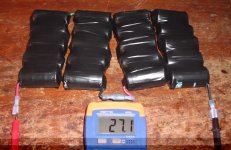Zapat,
I think a lot comes down to personal preference and how far you want to go with a protection scheme like this. What you have said about a cluster makes sense. The heat build-up will nearly always be greatest in the middle of a pack - so that is the obvious place to put one trip. Then distributing the trips throughout the pack according to how much you want to measure localized temperature. If you are not too worried abut getting the absolute maximum charge out of all cells then a derated temperature trip makes sense - this will lessen the need to monitor so many places throughout the pack. Heat will tend to spread fairly rapidly anyway (as long as the charging currents are not too high). You could also thermally bond a trip or two to a copper strip (or similar) going through the pack - this would tend to improve the sensing of the overall pack temperature and normalise the temperature being sensed by the trip. Do the likes of Dewalt/Hilti/Bosch have multiple thermal sensors in their packs (nimh)? I think they only use the one.
As above - I think it depends on how far you want to go with optimising each cluster independently - you could have multiple trips to monitor a string with each trip in series - if one of the thermal switches cuts out that string no longer receives any more charge (until the temperature drops). Only the separate charging leads to each string (or whatever arrangement you have) contains the trips. For discharge you do need a switch mechanism or connectors acting as cross-linking keys (if you are using strings which you parallel up to make the necessary connections) to join the outgoing power (postive) leads - either that or use diodes to isolate the charging feed wires.
So you have a thermal switch every how many cells for this to work well? I guess to have good thermal contact with the switch, round cells would have to be in groups of seven (this gives a hex shape cluster). Any more than this per group and the switch will too be far from some cells, no?
I think a lot comes down to personal preference and how far you want to go with a protection scheme like this. What you have said about a cluster makes sense. The heat build-up will nearly always be greatest in the middle of a pack - so that is the obvious place to put one trip. Then distributing the trips throughout the pack according to how much you want to measure localized temperature. If you are not too worried abut getting the absolute maximum charge out of all cells then a derated temperature trip makes sense - this will lessen the need to monitor so many places throughout the pack. Heat will tend to spread fairly rapidly anyway (as long as the charging currents are not too high). You could also thermally bond a trip or two to a copper strip (or similar) going through the pack - this would tend to improve the sensing of the overall pack temperature and normalise the temperature being sensed by the trip. Do the likes of Dewalt/Hilti/Bosch have multiple thermal sensors in their packs (nimh)? I think they only use the one.
While I agree that the extra resistance is not really a problem while charging, while discharging it will hit your efficiency and performance. What I don't quite understand here is how your "extra positive lead used just for charging" will manage to bypass ALL your thermal switches... Unless you bring out two leads from around each switch, and short them together when you are discharging the pack. Am I missing something or what?for a 48V pack, that's about 7 clusters per string, so 7 thermal switches, and thus about 14 or so wires to use as bypasses during discharge. And this is when you only have ONE string... imagine two or three!
As above - I think it depends on how far you want to go with optimising each cluster independently - you could have multiple trips to monitor a string with each trip in series - if one of the thermal switches cuts out that string no longer receives any more charge (until the temperature drops). Only the separate charging leads to each string (or whatever arrangement you have) contains the trips. For discharge you do need a switch mechanism or connectors acting as cross-linking keys (if you are using strings which you parallel up to make the necessary connections) to join the outgoing power (postive) leads - either that or use diodes to isolate the charging feed wires.



